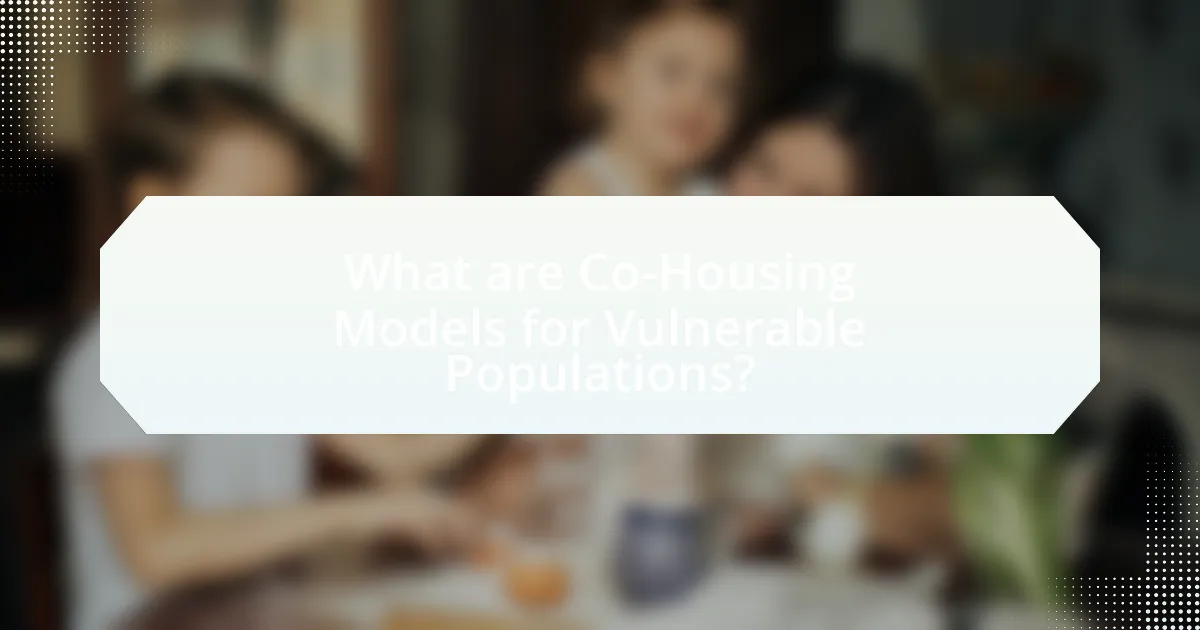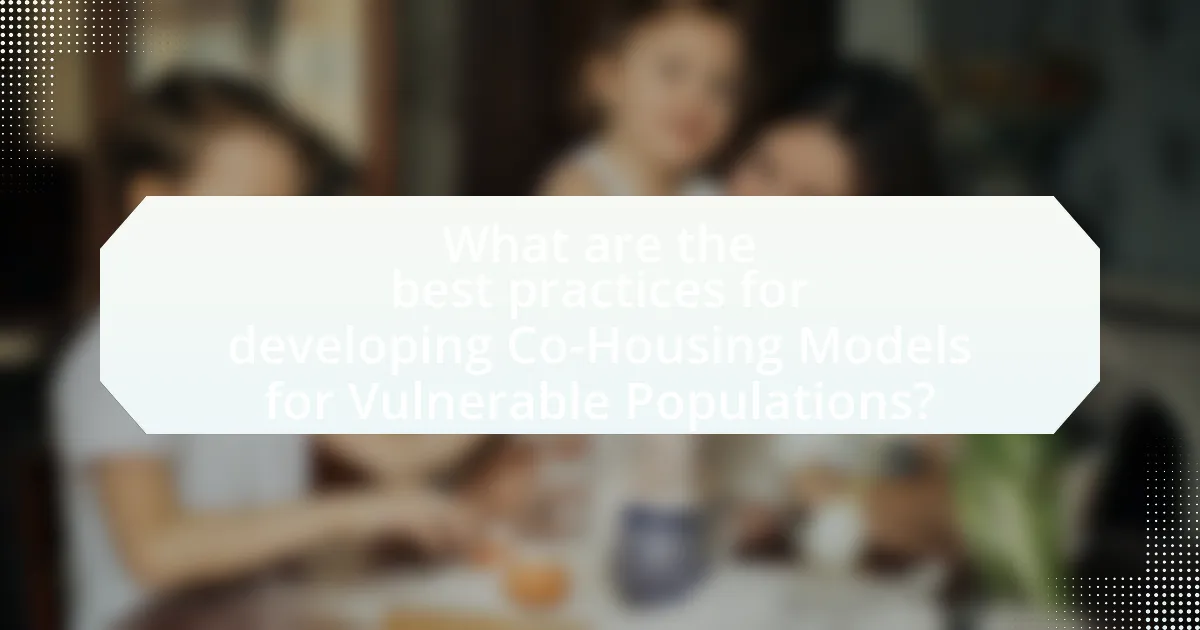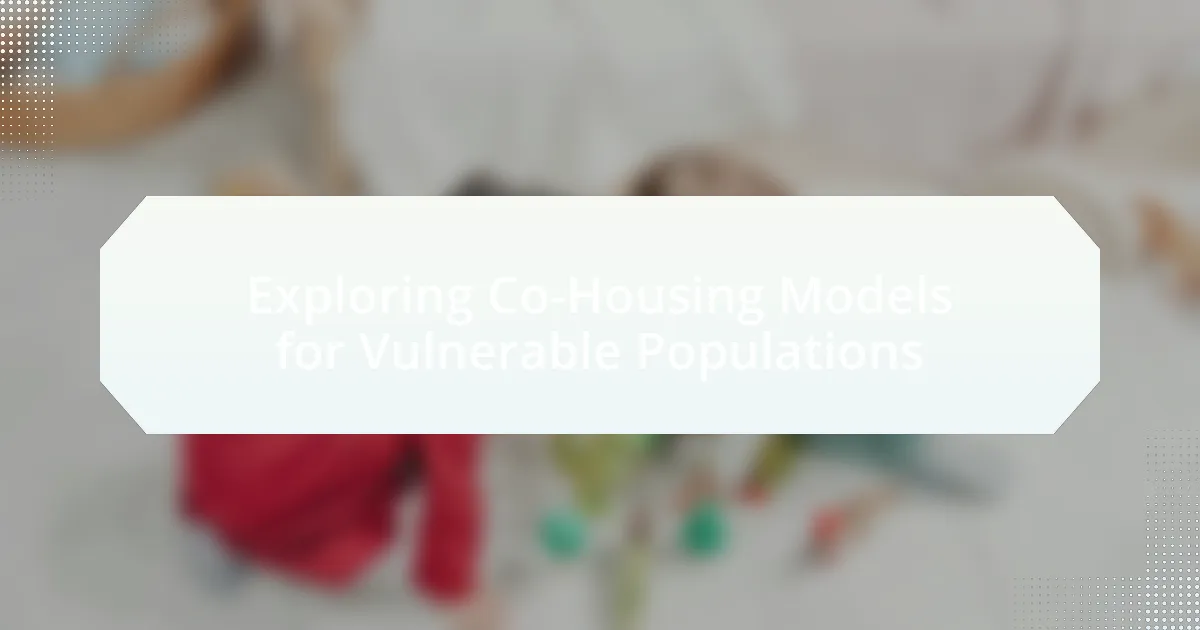Co-housing models for vulnerable populations are intentional communities that provide affordable housing and social support for individuals facing challenges such as low income, disability, or social isolation. These models emphasize shared spaces and resources, fostering collaboration and mutual assistance among residents, which can enhance social connections and improve mental well-being. The article explores the differences between co-housing and traditional housing solutions, the key characteristics and benefits of co-housing for various vulnerable groups, including the elderly and low-income families, and the principles for successful implementation. Additionally, it addresses the economic advantages, sustainability aspects, and best practices for developing co-housing initiatives, while also highlighting the challenges faced in their implementation.

What are Co-Housing Models for Vulnerable Populations?
Co-housing models for vulnerable populations are intentional communities designed to provide affordable housing and social support for individuals facing challenges such as low income, disability, or social isolation. These models typically feature shared spaces and resources, fostering collaboration and mutual assistance among residents. Research indicates that co-housing can enhance social connections and improve mental well-being, as evidenced by studies showing that residents experience lower levels of loneliness and higher levels of community engagement compared to traditional housing arrangements.
How do co-housing models differ from traditional housing solutions?
Co-housing models differ from traditional housing solutions primarily in their emphasis on community and shared resources. In co-housing, residents actively participate in the design and management of their living environment, fostering collaboration and social interaction, whereas traditional housing typically prioritizes individual ownership and privacy. Research indicates that co-housing can lead to improved social support networks and reduced isolation, which is particularly beneficial for vulnerable populations. For example, a study published in the Journal of Urban Affairs found that co-housing arrangements significantly enhance community engagement and well-being among residents compared to conventional housing setups.
What are the key characteristics of co-housing models?
Co-housing models are characterized by intentional communities where residents actively participate in the design and operation of their neighborhoods. These models typically feature private living spaces combined with shared common areas, fostering social interaction and collaboration among residents. Additionally, co-housing emphasizes sustainability through shared resources, such as gardens and communal facilities, which can reduce individual living costs and environmental impact. Research indicates that co-housing can enhance social support networks, particularly beneficial for vulnerable populations, by promoting a sense of belonging and community engagement.
Why are co-housing models particularly suited for vulnerable populations?
Co-housing models are particularly suited for vulnerable populations because they foster community support and shared resources, which are essential for individuals facing social or economic challenges. These models create an environment where residents can collaborate on daily tasks, share expenses, and provide emotional support, significantly enhancing their quality of life. Research indicates that co-housing can reduce feelings of isolation and improve mental health outcomes, as seen in studies like “The Role of Co-Housing in Supporting Vulnerable Populations” published in the Journal of Community Psychology, which highlights the positive impact of communal living on social connectedness and well-being.
What types of vulnerable populations benefit from co-housing?
Vulnerable populations that benefit from co-housing include the elderly, low-income families, individuals with disabilities, and single-parent households. Co-housing provides these groups with affordable housing options, social support, and shared resources, which can enhance their quality of life. For instance, studies have shown that elderly individuals in co-housing arrangements experience reduced loneliness and improved mental health due to increased social interaction and community engagement. Additionally, low-income families can access shared amenities and services, which can alleviate financial burdens.
How do co-housing models support the elderly?
Co-housing models support the elderly by fostering community engagement and providing shared resources that enhance their quality of life. These models create an environment where seniors can live independently while benefiting from social interaction and mutual support. Research indicates that co-housing arrangements can reduce feelings of isolation, which is crucial for mental health among the elderly. For instance, a study published in the Journal of Housing for the Elderly found that residents in co-housing communities reported higher levels of social satisfaction and lower levels of loneliness compared to those in traditional housing. Additionally, co-housing often includes shared facilities such as gardens, kitchens, and recreational areas, which promote collaboration and socialization among residents, further supporting their well-being.
What advantages do co-housing models offer to low-income families?
Co-housing models offer low-income families enhanced affordability, community support, and shared resources. These models reduce housing costs through shared ownership and maintenance expenses, making living more financially accessible. Additionally, co-housing fosters a sense of community, which can provide emotional and social support, crucial for families facing economic challenges. Research indicates that co-housing arrangements can lead to lower living expenses by up to 30% compared to traditional housing, as families share utilities, amenities, and communal spaces. This collaborative living environment not only alleviates financial burdens but also promotes social cohesion, which is vital for the well-being of low-income families.
What are the core principles of successful co-housing models?
The core principles of successful co-housing models include community engagement, shared resources, and participatory design. Community engagement fosters strong relationships among residents, which enhances social support and collaboration. Shared resources, such as communal spaces and facilities, reduce individual costs and promote sustainability. Participatory design involves residents in the planning and decision-making processes, ensuring that the living environment meets their needs and preferences. Research indicates that these principles lead to improved quality of life and increased social cohesion among residents in co-housing communities.
How does community engagement play a role in co-housing?
Community engagement is essential in co-housing as it fosters collaboration, trust, and shared responsibility among residents. This active participation leads to stronger social bonds, which are crucial for creating a supportive environment, particularly for vulnerable populations. Research indicates that co-housing communities with high levels of engagement report increased satisfaction and well-being among residents, as they benefit from shared resources and collective decision-making. For instance, a study by McCamant and Durrett in “Creating Cohousing: Building Sustainable Communities” highlights that engaged communities can effectively address individual and collective needs, enhancing the overall quality of life.
What governance structures are effective in co-housing communities?
Effective governance structures in co-housing communities typically include consensus decision-making, rotating leadership roles, and clear communication channels. Consensus decision-making fosters collaboration and ensures that all members have a voice, which is crucial for maintaining harmony in diverse groups. Rotating leadership roles prevent power imbalances and encourage participation from all members, enhancing community engagement. Clear communication channels, such as regular meetings and digital platforms, facilitate transparency and information sharing, which are essential for effective governance. Research indicates that these structures contribute to higher satisfaction and stability within co-housing communities, as they empower residents and promote a sense of ownership and responsibility.
How can co-housing models be implemented effectively?
Co-housing models can be implemented effectively by fostering strong community engagement and ensuring inclusive design. Engaging potential residents in the planning process promotes a sense of ownership and addresses specific needs, which is crucial for vulnerable populations. Research indicates that co-housing communities with active participation in decision-making lead to higher satisfaction and better social outcomes (McCamant & Durrett, 2011). Additionally, designing shared spaces that encourage interaction while providing private areas supports both community bonding and individual privacy, essential for diverse groups. Implementing these strategies can enhance the viability and success of co-housing initiatives for vulnerable populations.
What challenges do co-housing models face in implementation?
Co-housing models face significant challenges in implementation, primarily related to financing, community dynamics, and regulatory hurdles. Financing can be difficult due to the need for upfront capital and the often unconventional nature of co-housing arrangements, which may not align with traditional lending practices. Community dynamics pose another challenge, as successful co-housing requires strong interpersonal relationships and shared values among residents, which can be difficult to establish and maintain. Regulatory hurdles, including zoning laws and building codes, can impede the development of co-housing projects, as many local governments are not familiar with or supportive of these alternative housing models. These challenges are documented in studies such as “Co-housing: A Contemporary Approach to Housing” by Kathryn McCamant and Charles Durrett, which highlight the complexities involved in creating sustainable co-housing communities.

What are the benefits of Co-Housing Models for Vulnerable Populations?
Co-housing models provide numerous benefits for vulnerable populations, including enhanced social support, affordability, and improved mental health. These models foster a sense of community, which can significantly reduce feelings of isolation often experienced by vulnerable individuals. Research indicates that co-housing arrangements can lower living costs through shared resources, making housing more accessible for low-income groups. Additionally, studies have shown that communal living environments can lead to better mental health outcomes, as residents often experience increased social interaction and emotional support. For instance, a study published in the Journal of Community Psychology found that participants in co-housing settings reported higher levels of life satisfaction and lower levels of depression compared to those in traditional housing.
How do co-housing models enhance social support networks?
Co-housing models enhance social support networks by fostering close-knit communities where residents share resources and responsibilities. This communal living arrangement encourages regular interaction among members, which strengthens relationships and builds trust. Research indicates that co-housing environments lead to increased social engagement, as residents often participate in communal activities and decision-making processes, thereby reducing feelings of isolation. A study published in the Journal of Community Psychology found that individuals in co-housing settings reported higher levels of social support and well-being compared to those in traditional housing. This evidence underscores the effectiveness of co-housing in creating supportive networks that benefit vulnerable populations.
What impact does shared living have on mental health?
Shared living positively impacts mental health by fostering social connections and reducing feelings of isolation. Research indicates that individuals in co-housing arrangements report higher levels of emotional support and community engagement, which are crucial for mental well-being. A study published in the Journal of Community Psychology found that residents in shared living environments experienced lower rates of depression and anxiety compared to those living alone, highlighting the mental health benefits of communal living.
How does co-housing promote resource sharing among residents?
Co-housing promotes resource sharing among residents by creating a collaborative living environment where communal spaces and shared resources are integral to the community design. This model encourages residents to pool resources such as tools, appliances, and communal gardens, which reduces individual costs and fosters a sense of community. Research indicates that co-housing communities often have shared facilities like kitchens, laundry rooms, and recreational areas, which not only enhance social interaction but also optimize resource use, leading to lower environmental impact and increased sustainability. For example, a study by McCamant and Durrett in “Creating Cohousing: Building Sustainable Communities” highlights that co-housing residents typically save 30-50% on household expenses through shared resources, demonstrating the financial and social benefits of this living arrangement.
What economic advantages do co-housing models provide?
Co-housing models provide significant economic advantages by reducing individual housing costs through shared resources and communal living arrangements. By pooling financial resources, residents can lower expenses related to utilities, maintenance, and property taxes, leading to overall cost savings. For instance, a study by the National Cooperative Bank found that co-housing communities can reduce housing costs by 20-50% compared to traditional housing models. Additionally, shared amenities such as kitchens, gardens, and recreational spaces further decrease individual expenditures while fostering a sense of community and support among residents.
How can co-housing reduce living costs for residents?
Co-housing can reduce living costs for residents by enabling shared resources and communal living arrangements. This model allows residents to pool expenses for utilities, maintenance, and shared amenities, significantly lowering individual financial burdens. For instance, a study by the National Cooperative Business Association found that co-housing communities can reduce housing costs by 20-50% compared to traditional housing due to shared infrastructure and collective purchasing power. Additionally, shared responsibilities for upkeep and communal spaces further decrease the overall cost of living, making housing more affordable for vulnerable populations.
What funding opportunities exist for co-housing projects?
Funding opportunities for co-housing projects include government grants, low-interest loans, and private investments. For instance, the U.S. Department of Housing and Urban Development (HUD) offers various grant programs aimed at supporting affordable housing initiatives, which can be utilized for co-housing developments. Additionally, community development financial institutions (CDFIs) provide low-interest loans specifically for projects that benefit low-income populations. Furthermore, crowdfunding platforms have emerged as a viable option for raising capital, allowing individuals to invest in co-housing projects directly. These funding sources are crucial for the successful establishment and sustainability of co-housing communities, particularly for vulnerable populations.
How do co-housing models contribute to community resilience?
Co-housing models enhance community resilience by fostering social connections and shared resources among residents. These models create a supportive environment where individuals collaborate on communal activities, which strengthens relationships and trust within the community. Research indicates that communities with strong social ties are better equipped to respond to crises, as evidenced by a study published in the Journal of Community Psychology, which found that neighborhoods with higher levels of social cohesion experienced lower rates of crime and improved mental health outcomes during stressful events. Additionally, co-housing arrangements often include shared facilities, such as gardens and kitchens, which promote resource sharing and reduce individual reliance on external systems, further contributing to the community’s ability to withstand challenges.
What role does sustainability play in co-housing initiatives?
Sustainability is a fundamental aspect of co-housing initiatives, as it promotes environmentally friendly living and resource efficiency. Co-housing designs often incorporate shared resources, such as communal gardens and energy-efficient buildings, which reduce individual consumption and lower carbon footprints. For instance, studies show that co-housing communities can achieve up to 30% lower energy use compared to traditional housing models due to shared facilities and collective decision-making on sustainable practices. This collaborative approach not only fosters a sense of community but also enhances the resilience of vulnerable populations by providing affordable housing options while minimizing environmental impact.
How can co-housing models foster inclusivity and diversity?
Co-housing models can foster inclusivity and diversity by creating intentional communities that prioritize shared resources and collaborative living. These models encourage diverse populations to live together, promoting social interaction and mutual support among residents from various backgrounds. Research indicates that co-housing environments can reduce social isolation, enhance community engagement, and provide a platform for cultural exchange, which contributes to a more inclusive atmosphere. For instance, a study by McCamant and Durrett in “Creating Cohousing: Building Sustainable Communities” highlights how co-housing designs facilitate interaction through shared spaces, leading to increased understanding and acceptance among residents of different ages, ethnicities, and socioeconomic statuses.

What are the best practices for developing Co-Housing Models for Vulnerable Populations?
The best practices for developing co-housing models for vulnerable populations include community engagement, inclusive design, and sustainable funding mechanisms. Community engagement ensures that the needs and preferences of vulnerable groups are prioritized, fostering a sense of ownership and belonging. Inclusive design addresses accessibility and adaptability, accommodating diverse needs such as mobility challenges or family structures. Sustainable funding mechanisms, such as partnerships with local governments and non-profits, provide financial stability and resources necessary for long-term success. Research indicates that co-housing initiatives that incorporate these practices have higher rates of resident satisfaction and community cohesion, as evidenced by studies conducted by the National Cooperative Housing Coalition.
How can stakeholders collaborate effectively in co-housing projects?
Stakeholders can collaborate effectively in co-housing projects by establishing clear communication channels and shared goals. Effective collaboration involves regular meetings, transparent decision-making processes, and inclusive participation from all stakeholders, including residents, developers, and local authorities. Research indicates that co-housing projects with structured governance models, such as consensus decision-making, enhance stakeholder engagement and satisfaction. For instance, a study by McCamant and Durrett in “Creating Cohousing: Building Sustainable Communities” highlights that successful co-housing communities often utilize collaborative tools like workshops and planning sessions to align interests and foster a sense of community.
What strategies can be employed to engage potential residents?
To engage potential residents in co-housing models for vulnerable populations, strategies such as community outreach, participatory design workshops, and informational sessions can be employed. Community outreach involves connecting with local organizations and social services to identify and reach out to individuals who may benefit from co-housing. Participatory design workshops allow potential residents to contribute their ideas and preferences, fostering a sense of ownership and investment in the community. Informational sessions provide education about the benefits of co-housing, addressing concerns and misconceptions while highlighting success stories from existing co-housing communities. These strategies have been shown to increase interest and participation, as evidenced by studies indicating that community involvement leads to higher satisfaction and retention rates among residents in co-housing settings.
How can local governments support co-housing initiatives?
Local governments can support co-housing initiatives by providing financial incentives, zoning adjustments, and facilitating community engagement. Financial incentives, such as grants or low-interest loans, can help reduce the initial costs for co-housing projects, making them more accessible. Zoning adjustments can allow for higher density housing and mixed-use developments, which are essential for co-housing models. Additionally, local governments can facilitate community engagement by organizing workshops and forums that educate residents about co-housing benefits and encourage participation in the planning process. These actions have been shown to increase the viability of co-housing projects, as evidenced by successful initiatives in cities like Portland, Oregon, where supportive policies have led to a significant rise in co-housing developments.
What lessons can be learned from existing co-housing communities?
Existing co-housing communities demonstrate the importance of shared resources and social interaction in enhancing quality of life. These communities often foster a strong sense of belonging and support among residents, which can lead to improved mental health and reduced feelings of isolation. For instance, a study by McCamant and Durrett in “Creating Cohousing: Building Sustainable Communities” highlights that co-housing arrangements can significantly lower living costs through shared amenities, such as kitchens and gardens, while also promoting sustainable living practices. Furthermore, the collaborative decision-making processes in these communities empower residents, allowing them to have a direct impact on their living environment and community dynamics. This participatory approach has been shown to increase satisfaction and engagement among residents, as evidenced by surveys conducted in various co-housing projects across the United States.
What successful case studies illustrate effective co-housing models?
Successful case studies illustrating effective co-housing models include EcoVillage in Ithaca, New York, and the cohousing community in Boulder, Colorado. EcoVillage, established in 1991, integrates sustainable living with community engagement, featuring shared resources and communal spaces that foster social interaction among residents. The Boulder cohousing community, founded in 1996, emphasizes collaborative decision-making and shared responsibilities, resulting in a supportive environment for families and individuals. Both case studies demonstrate the effectiveness of co-housing in enhancing social ties and providing affordable housing solutions, supported by research indicating that such models can improve residents’ well-being and reduce isolation.
How can challenges faced by existing communities inform future projects?
Challenges faced by existing communities can inform future projects by highlighting specific needs and gaps in services that must be addressed. For instance, communities experiencing high rates of homelessness often reveal the necessity for affordable housing solutions, which can guide the design of co-housing models that prioritize accessibility and inclusivity. Research indicates that co-housing initiatives, such as those documented in the “Journal of Urban Affairs,” demonstrate improved social cohesion and resource sharing among residents, which can be directly informed by understanding the struggles of current communities. By analyzing these challenges, future projects can be tailored to create environments that not only meet the immediate needs of vulnerable populations but also foster long-term sustainability and resilience.
What practical steps can individuals take to advocate for co-housing?
Individuals can advocate for co-housing by organizing community meetings to raise awareness and gather support. These meetings can facilitate discussions about the benefits of co-housing, such as affordability and social interaction, which are particularly relevant for vulnerable populations. Additionally, individuals can collaborate with local government officials to promote policies that support co-housing developments, as evidenced by successful initiatives in cities like Portland, Oregon, where zoning changes have enabled co-housing projects. Engaging with existing co-housing groups can also provide valuable insights and resources, enhancing advocacy efforts.

Leave a Reply